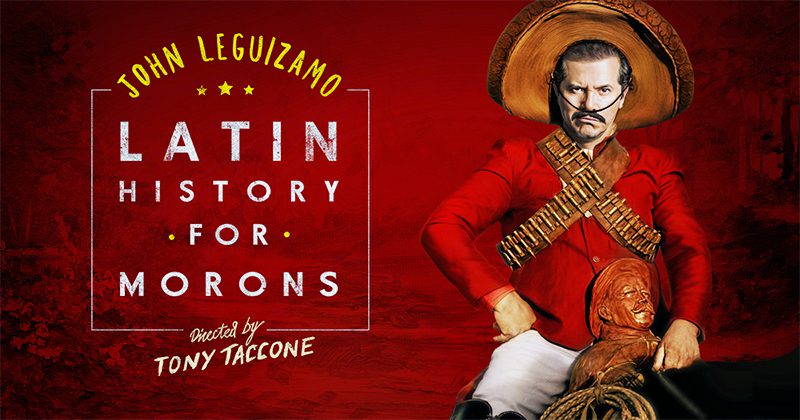
In his latest venture, John Leguizamo takes to the stage to give a lesson about the contributions of Latin heroes to the world. Using his own struggles as a father attempting to impart cultural pride in his son who is being bullied at school for being Latino, Leguizamo journeys through his intellectual and emotional pursuit of highlighting the great contributions that Latin persons have made to society and they ways in which they changed history. In Latin History for Morons, Leguizamo uses his talents as a writer and actor to meditate on the challenges he faced as a child and subsequently a parent, in a world founded on exploiting and demeaning Latinos. Netflix brings this Tony-nominated play produced and performed by the veteran actor into our homes, allowing us the opportunity to experience the heartfelt playfulness that undergirds Leguizamo’s work.
Although Latin History for Morons serves as both a lesson and a personal reflection, Leguizamo’s intentional classroom structure and overall use of humor eliminates condescension that is often found with didactic pieces, instead allowing us to laugh while we learn. The performer appears on stage dressed as a kooky professor with slightly unkempt hair sitting on his head, a tweed jacket and tie on his shoulders with jeans and black Converse sneakers. The stage is an organized mess of books, file cabinets, a cork board littered with papers, and a chalkboard on wheels that the “self-professed ghetto scholar” on a “intellectual jihad” uses to educate his audiences. Leguizamo walks us through the ancient Mayan and Aztec civilizations to our contemporary times with our current President working to repeal DACA and build a wall between the U.S. and Mexico.
What makes his performance so engaging is how he uses his entire self to bring history to life. He acts out battles between the indigenous peoples of the Americas and Spanish conquistadors, uses dance and song to punctuate his points about Latin culture, and even imitates his therapist. He changes his hair onstage, makes funny voices, and even takes off his pants to reveal bright red underwear that matches his tie. At times he uses stereotypes as evidenced in his manner of speaking and his movement. While at first, I was unsure of how to interpret this strategy, I came to understand that he employed it as a method of relating with and connecting to the audience. Since his stereotypes are not in poor taste and they serve a greater purpose, I was able to reconcile my initial reservation about their presence.
Leguizamo uses the pursuit of knowledge to uncover and better understand the source of his anger issues – “unconscious conquest resentment.” In attempt to help other Latinos do the same and to educate non-Latinos, he peppers his performance with the titles and authors of the books he has read, providing a voiced bibliography. By showing his sources, Leguizamo not only gives credit where credit is due but reinforces humor as a great way of learning about our relationship the world, to one another, and to ourselves.







